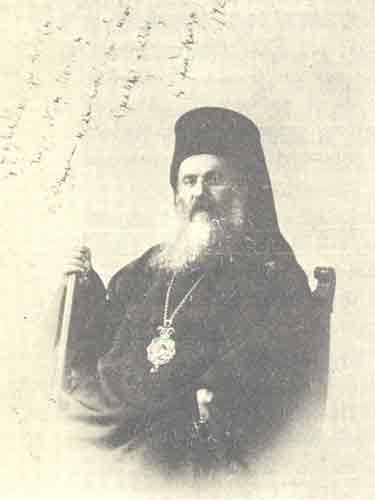People
Greek Asia Minor Campaign (1919-1922)
Hrisostomos (1867-1922)
«One of the keenest impressions which I brought away with me from Smyrna was a feeling of shame that I belonged to the human race.» George Horton |
Hrisostomos {Χρυσόστομος} (1867-1922). Greek Orthodox Eparch {Mitropolitis ~ Μητροπολίτης} of Smyrna (Smirni ~ Σμύρνη}. Smyrna, now known as Izmir, fell on September 8th, 1922, and Turkish Irregulars, known as Çetes (Çete = gang or mob) set fire to it. Tens of thousands of Greeks from Asia Minor who did not get away in time were massacred by the Turks.
The Greek army is reckoned to have lost 40,000 men, while those wounded or missing were in excess of 50,000. Furthermore, it is estimated that 300,000 men, women and children were slaughtered by the rampaging Turkish mob. Eparch Hrisostomos was among them and was hacked to pieces.
In a paper printed in 1925 (three years after the disaster) war correspondent Kostas Misailidis {Κώστας Μισαηλίδης} wrote about the last days of Smyrna. The details he gave concerning Eparch Hrisostomos' martyrdom are heart-rending. He wrote:
Shortly before midday on Sunday September 10th, 1922, Turkish
General Nuredin Paşa had the Eparch taken out of the garrison headquarters.
"Here are your judges and your executioners", the Turkish Garrison Commander,
Colonel Zakim Salih Efendi, told him.
And he handed him over to the raging mob which had spent the whole night there waiting for
him -- having been told to do so by Nuredin Paşa.
And the torment began.
The road from Government House Square to Iki Çeşme Square - in a Turkish district of
Smyrna - grew wild with the torment dealt to this new National Martyr.
His eyes were plucked out with a bayonet. His ears were cut off and his tongue cut out. He
was dragged along by the beard and hair. With inhuman and unimaginably barbaric Turkish
fury they started doing the most repulsive dance round his body. No harsh or debasing act
was omitted from their treatment of Eparch Hrisostomos' wasted, half dead body.
So the Eparch of Smyrna was dragged in this way to Iki Çeşme; hacked to pieces. There
the crowd, intoxicated with brutality, ripped off pieces of Eparch Hrisostomos' flesh as
bloody talismans. His bruised and battered head, dripping with blood, the eyes gouged out,
the ears cut off, the tongue cut out and the beard ripped off was impaled on his pastoral
staff and paraded around the Turkish neighbourhoods with scorn and blasphemy in a maniacal
procession.
Despite the mechanistic logic and cool detachment which are characteristic features of his style, Ioannis Kordatos {Ιωάννης Κορδάτος} wrote about the disaster:
On September 8th, the Turks entered Smyrna and burnt it. What
followed is indescribable. Pure hell. The Greek residents rushed to the sea front. Some in
boats and others swimming in the water made their way to the French, British and Italian
warships, seeking asylum.
But when they clambered onto the ships, the sailors threw them back into the sea. They
even cut off their hands and kicked them off. The Turks slaughtered Eparch Hrisostomos and
many more people from Smyrna.
Great weeping and wailing. The flames reached the sky and blood flowed in the streets of
Giaour Smyrna which had for many years been the industrial and commercial capital of Asia
Minor. Bodies floated in the harbour for many days after.
Source: Ιστορία της Νεώτερης Ελλάδας ({Istoria tis Neoteris Elladas} =
History of Modern Greece), vol: V, p. 577).
Hrisostomos (1867-1922)

04-23-2004